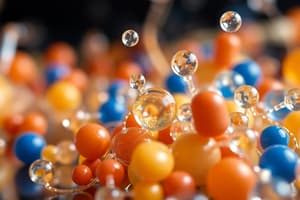Podcast
Questions and Answers
Which property makes Polyphenylene Sulfide (PPS) particularly valuable in its applications?
Which property makes Polyphenylene Sulfide (PPS) particularly valuable in its applications?
- Dimensional stability
- Excellent chemical and thermal stability (correct)
- Low friction
- High toughness
What is a primary application of PVC pipes?
What is a primary application of PVC pipes?
- Potable water
- Water distribution and sewage systems (correct)
- Geotextiles
- Gas distribution
Which thermoplastic is used for structural reinforcements in construction?
Which thermoplastic is used for structural reinforcements in construction?
- Polyacetals
- Polypropylene blends
- Fiber-Reinforced Thermoplastics (FRTP) (correct)
- Polystyrene
Which thermoplastics are commonly used for thermal insulation in buildings?
Which thermoplastics are commonly used for thermal insulation in buildings?
What is a characteristic benefit of using HDPE pipes?
What is a characteristic benefit of using HDPE pipes?
Which application utilizes geosynthetics for environmental protection?
Which application utilizes geosynthetics for environmental protection?
What is a disadvantage of using advanced thermoplastics compared to commodity plastics?
What is a disadvantage of using advanced thermoplastics compared to commodity plastics?
Which property is associated with Polyacetals?
Which property is associated with Polyacetals?
What property of semicrystalline thermoplastics defines the temperature at which they transition to a fully liquid state?
What property of semicrystalline thermoplastics defines the temperature at which they transition to a fully liquid state?
Which thermoplastic is known for its flexibility and is often used in consumer goods?
Which thermoplastic is known for its flexibility and is often used in consumer goods?
What is a key characteristic of polycarbonates that allows them to absorb significant stress?
What is a key characteristic of polycarbonates that allows them to absorb significant stress?
Which property of polycarbonates enhances their suitability for electrical applications?
Which property of polycarbonates enhances their suitability for electrical applications?
Which property measures a thermoplastic's resistance to deformation under long-term stress?
Which property measures a thermoplastic's resistance to deformation under long-term stress?
What is the characteristic of engineering thermoplastics compared to commodity thermoplastics?
What is the characteristic of engineering thermoplastics compared to commodity thermoplastics?
Which temperature can polycarbonates withstand without significant degradation?
Which temperature can polycarbonates withstand without significant degradation?
Which thermoplastic type is typically used in applications requiring impact resistance and transparency?
Which thermoplastic type is typically used in applications requiring impact resistance and transparency?
How does the presence of UV stabilizers affect polycarbonates?
How does the presence of UV stabilizers affect polycarbonates?
In which application would polycarbonate's optical clarity be especially utilized?
In which application would polycarbonate's optical clarity be especially utilized?
Which thermal property indicates the temperature at which a thermoplastic deforms under a specific load?
Which thermal property indicates the temperature at which a thermoplastic deforms under a specific load?
What processing methods are suitable for polycarbonates?
What processing methods are suitable for polycarbonates?
What does the impact resistance of thermoplastics refer to?
What does the impact resistance of thermoplastics refer to?
Which of the following concludes the properties of polycarbonate relevant to construction applications?
Which of the following concludes the properties of polycarbonate relevant to construction applications?
How does the thermal conductivity of thermoplastics generally compare to metals?
How does the thermal conductivity of thermoplastics generally compare to metals?
What is an added benefit of coating polycarbonates for scratch resistance?
What is an added benefit of coating polycarbonates for scratch resistance?
Which applications in the automotive industry commonly utilize thermosetting polymers?
Which applications in the automotive industry commonly utilize thermosetting polymers?
What is a common characteristic of elastomers?
What is a common characteristic of elastomers?
Which type of elastomer is best known for its excellent heat resistance?
Which type of elastomer is best known for its excellent heat resistance?
In which industry are epoxy-based composites and polyimides primarily used?
In which industry are epoxy-based composites and polyimides primarily used?
Which characteristic of thermosetting polymers makes them unsuitable for recycling?
Which characteristic of thermosetting polymers makes them unsuitable for recycling?
What type of elastomer is engineered for high abrasion resistance and used in applications like wheels and seals?
What type of elastomer is engineered for high abrasion resistance and used in applications like wheels and seals?
Which thermosetting polymer is often used in construction for coatings and adhesives?
Which thermosetting polymer is often used in construction for coatings and adhesives?
What type of synthetic rubber is known for its resistance to ozone and chemicals?
What type of synthetic rubber is known for its resistance to ozone and chemicals?
What characterizes thermosetting polymers?
What characterizes thermosetting polymers?
Which property makes thermosetting polymers ideal for high-temperature applications?
Which property makes thermosetting polymers ideal for high-temperature applications?
What is a disadvantage of thermosetting polymers?
What is a disadvantage of thermosetting polymers?
Which application commonly uses thermosetting polymers?
Which application commonly uses thermosetting polymers?
What is the impact of the irreversible curing process of thermosetting polymers on recycling?
What is the impact of the irreversible curing process of thermosetting polymers on recycling?
How do thermosetting polymers behave under constant stress or load?
How do thermosetting polymers behave under constant stress or load?
Which statement about thermosetting polymers is true regarding their strength?
Which statement about thermosetting polymers is true regarding their strength?
What happens to thermosetting polymers when they are cured?
What happens to thermosetting polymers when they are cured?
What is one of the key benefits of Polyphenylene Sulfide (PPS) regarding its chemical properties?
What is one of the key benefits of Polyphenylene Sulfide (PPS) regarding its chemical properties?
Which property of PPS makes it suitable for electrical insulation applications?
Which property of PPS makes it suitable for electrical insulation applications?
What characteristic allows PPS to remain effective under thermal cycling?
What characteristic allows PPS to remain effective under thermal cycling?
In which industry would you expect to find PPS being used for components exposed to high temperatures?
In which industry would you expect to find PPS being used for components exposed to high temperatures?
Which property of PPS makes it less suitable for outdoor applications?
Which property of PPS makes it less suitable for outdoor applications?
What is one application of PPS in the aerospace industry?
What is one application of PPS in the aerospace industry?
Which of these is a significant advantage of using PPS in manufacturing?
Which of these is a significant advantage of using PPS in manufacturing?
What makes PPS resistant to mechanical stress?
What makes PPS resistant to mechanical stress?
Flashcards
Thermoplastics
Thermoplastics
A class of polymers that soften when heated and solidify upon cooling, allowing them to be reshaped multiple times.
Glass Transition Temperature (Tg)
Glass Transition Temperature (Tg)
The temperature at which an amorphous thermoplastic transitions from a rigid, glassy state to a flexible, rubbery state.
Melting Point (Tm)
Melting Point (Tm)
The temperature at which a semicrystalline thermoplastic melts and becomes a liquid.
Heat Deflection Temperature (HDT)
Heat Deflection Temperature (HDT)
Signup and view all the flashcards
Engineering Thermoplastics
Engineering Thermoplastics
Signup and view all the flashcards
Polycarbonate (PC)
Polycarbonate (PC)
Signup and view all the flashcards
Impact Resistance
Impact Resistance
Signup and view all the flashcards
Creep Resistance
Creep Resistance
Signup and view all the flashcards
Polyphenylene sulfide (PPS)
Polyphenylene sulfide (PPS)
Signup and view all the flashcards
Chemical Resistance of PPS
Chemical Resistance of PPS
Signup and view all the flashcards
Mechanical Strength of PPS
Mechanical Strength of PPS
Signup and view all the flashcards
Polyamide (Nylon)
Polyamide (Nylon)
Signup and view all the flashcards
Electrical Insulation of PPS
Electrical Insulation of PPS
Signup and view all the flashcards
Polyacetal
Polyacetal
Signup and view all the flashcards
Low Friction and Wear Resistance of PPS
Low Friction and Wear Resistance of PPS
Signup and view all the flashcards
Flame Retardant Properties of PPS
Flame Retardant Properties of PPS
Signup and view all the flashcards
Applications of Polyamides, PPS, and Polyacetals
Applications of Polyamides, PPS, and Polyacetals
Signup and view all the flashcards
Thermal Stability of PPS
Thermal Stability of PPS
Signup and view all the flashcards
PVC Pipes
PVC Pipes
Signup and view all the flashcards
HDPE Pipes
HDPE Pipes
Signup and view all the flashcards
Applications of PPS
Applications of PPS
Signup and view all the flashcards
Geomembranes
Geomembranes
Signup and view all the flashcards
Geotextiles
Geotextiles
Signup and view all the flashcards
Thermosetting Polymer
Thermosetting Polymer
Signup and view all the flashcards
Curing (Thermosets)
Curing (Thermosets)
Signup and view all the flashcards
High Thermal Stability
High Thermal Stability
Signup and view all the flashcards
Chemical Resistance
Chemical Resistance
Signup and view all the flashcards
Electrical Insulation
Electrical Insulation
Signup and view all the flashcards
Brittleness
Brittleness
Signup and view all the flashcards
Low Creep
Low Creep
Signup and view all the flashcards
Surface Hardness
Surface Hardness
Signup and view all the flashcards
Dimensional Stability
Dimensional Stability
Signup and view all the flashcards
Heat Resistance of Polycarbonates
Heat Resistance of Polycarbonates
Signup and view all the flashcards
Transparency of Polycarbonates
Transparency of Polycarbonates
Signup and view all the flashcards
Ease of Processing Polycarbonates
Ease of Processing Polycarbonates
Signup and view all the flashcards
UV Resistance of Polycarbonates
UV Resistance of Polycarbonates
Signup and view all the flashcards
Electrical Insulation of Polycarbonates
Electrical Insulation of Polycarbonates
Signup and view all the flashcards
Chemical Resistance of Polycarbonates
Chemical Resistance of Polycarbonates
Signup and view all the flashcards
What are thermosetting polymers?
What are thermosetting polymers?
Signup and view all the flashcards
What are elastomers?
What are elastomers?
Signup and view all the flashcards
What are the properties of natural rubber?
What are the properties of natural rubber?
Signup and view all the flashcards
How do synthetic rubbers compare to natural rubber?
How do synthetic rubbers compare to natural rubber?
Signup and view all the flashcards
What are the key advantages of silicone rubber?
What are the key advantages of silicone rubber?
Signup and view all the flashcards
What are the main uses of polyurethane?
What are the main uses of polyurethane?
Signup and view all the flashcards
What is the main advantage of fluorocarbon rubber?
What is the main advantage of fluorocarbon rubber?
Signup and view all the flashcards
How are thermosetting polymers used?
How are thermosetting polymers used?
Signup and view all the flashcards
Study Notes
Introduction to Plastics
- Plastics are large molecules composed of repeating structural units (monomers) linked by covalent bonds.
- They occur naturally (e.g., proteins, cellulose) or are synthesized (e.g., plastics, synthetic fibers).
- Plastics are categorized into thermoplastics, thermosets, and elastomers based on their behavior and structure.
Introduction to Polymers
- Polymers are large molecules composed of repeating structural units (monomers) linked by covalent bonds.
- They occur naturally and can be synthesized.
- Polymers are classified into three main categories based on their behavior and structure: thermoplastics, thermosets, and elastomers.
Importance of Polymers
- Versatility: Diverse properties (flexibility, strength, transparency) lead to use in a wide range of applications.
- Cost-efficiency: Cheaper than many natural materials, particularly in mass production.
- Lightweight: Lower density makes them ideal for automotive and aerospace applications.
- Durability and chemical resistance: High resistance to chemicals, weather, and wear makes them suitable for construction, medical devices, and packaging.
- Energy and resource efficiency: Often replace high-energy materials like metals and wood.
- Sustainability: Biodegradable and recyclable polymers aim for reduced environmental impact.
Thermoplastics Overview
- Definition: Polymers that soften when heated and solidify when cooled, can be reheated and reshaped multiple times without significant chemical changes.
- Common types include Polyethylene (PE), Polypropylene (PP), and Polystyrene (PS).
- Properties:
- Reusability: Can be repeatedly melted and reshaped, making them recyclable.
- Temperature sensitivity: Softens with heat, easy molding into complex shapes..
- Mechanical properties: Less rigid than thermosets, with varying properties like flexibility and impact resistance.
- Amorphous vs. Semicrystalline: Amorphous thermoplastics (e.g., polystyrene) are more transparent and often brittle, while semicrystalline thermoplastics (e.g., polyethylene) are more opaque, tougher, and have higher chemical resistance.
- Thermal Properties: Heat sensitivity (softens with heat), Glass Transition Temperature (Tg), Melting Point (Tm), Heat Deflection Temperature (HDT). Thermal Conductivity: Generally low (insulating).
- Mechanical properties: Flexibility and Toughness, Tensile Strength, Impact Resistance, Creep Resistance, Hardness and Density.
- Applications: Packaging, consumer goods, automotive components, and medical devices.
Engineering Thermoplastics Overview
- A class of high-performance thermoplastics with superior mechanical, thermal, and chemical properties compared to commodity thermoplastics.
- Properties: Durability, Heat Resistance, Enhanced Mechanical Properties (high tensile strength and stiffness; excellent creep and fatigue resistance under load).
- Typical Examples: Polycarbonates (PC), Polyamides (Nylon), Polyphenylene Sulfide (PPS), Polyacetals.
- Applications: Automotive components, electrical and electronic devices, industrial machinery, medical equipment.
Applications of Thermoplastics
- Piping systems (PVC pipes, HDPE pipes).
- Geosynthetics (geomembranes, geotextiles).
- Structural components (fiber-reinforced thermoplastics, composite decking).
- Insulation and protective barriers (thermal insulation, waterproofing).
- Concrete formworks and reinforcement (plastic formwork, rebar spacers).
- Road and pavement applications (traffic barriers, reflective markers).
Poly(butylene terephthalate) (PBT)
- Properties: Thermal stability, mechanical strength, chemical resistance, moisture resistance, electrical properties, self-lubricating.
- Applications: Automotive parts, electrical/electronic components, industrial machinery, appliances, consumer goods.
Polyamides (Nylon)
- Properties: High strength and toughness, good chemical resistance, moisture sensitivity, thermal stability, low friction, fatigue resistance.
- Applications: Automotive parts, mechanical and industrial equipment, electrical and electronics, fibers, construction applications.
Polyacetals
- Properties: High strength and rigidity, low friction and self-lubricating, good chemical resistance, dimensional stability, fatigue resistance, thermal properties.
- Applications: Automotive components, electrical and electronics, industrial machinery, plumbing and fluid handling.
Polyphenylene Sulfide (PPS)
- Properties: High temperature resistance (withstands high temperatures), chemical resistance (resistant to acids, bases, organic solvents), mechanical strength, electrical insulation, low friction, flame retardancy.
- Applications: Automotive industry (high-performance components), electrical and electronics (enclosures, insulators), aerospace, industrial applications (components in pumps, valves, and seals).
Polycarbonates
- Properties: High impact strength, transparency, heat resistance, dimensional stability, good electrical insulation, UV resistance (with additives), flame retardancy (with additives), ease of processing, scratch resistance (with coatings), chemical resistance.
- Applications: Automotive industry (headlamp lenses, interior components), aerospace (transparent panels), electrical and electronics (insulating materials), construction and architecture (architectural glazing, skylights).
Thermosetting Polymers
- Definition: Polymers that undergo an irreversible curing process forming a rigid, three-dimensional network structure once cured.
- Properties: Irreversible curing, high thermal stability (withstand high temperatures without softening), excellent mechanical properties (high strength, rigidity, dimensional stability), chemical resistance, electrical insulation, brittleness (generally more brittle than thermoplastics).
- Applications: Automotive industry, aerospace, electrical and electronics, construction and civil engineering (coatings, adhesives, sealants), oil and gas industry (seals, gaskets).
Elastomers
- Definition: Highly elastic materials undergoing large strains and returning to their original shape after stress is removed.
- Types: Natural rubber, synthetic rubber (e.g., SBR, NBR, EPDM, Neoprene), silicone rubber, polyurethane (PU), fluorocarbon rubber (FKM).
- Properties: High elasticity, low modulus of elasticity, excellent compression set resistance, good temperature resistance, tear and abrasion resistance, chemical resistance, low creep, electrical insulation, UV resistance.
- Applications: Automotive industry, construction, medical, electrical, and industrial applications.
Studying That Suits You
Use AI to generate personalized quizzes and flashcards to suit your learning preferences.
Related Documents
Description
This quiz covers the fundamentals of plastics and polymers, including their structure, types, and importance in various applications. Learn about thermoplastics, thermosets, and elastomers, and understand why these materials are crucial in modern technology and industry.




